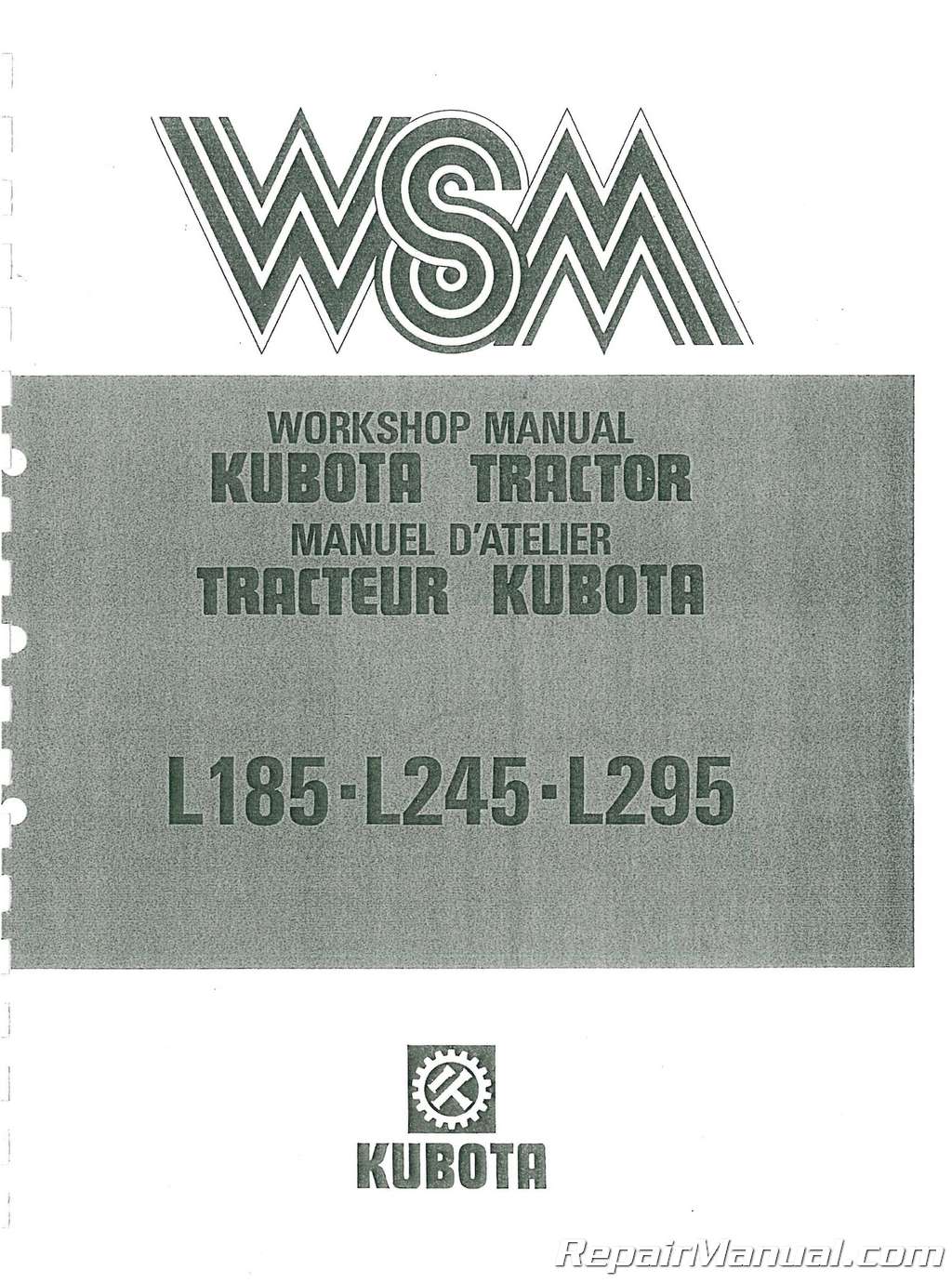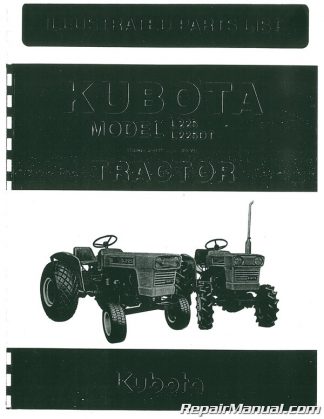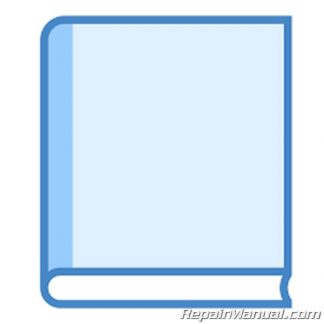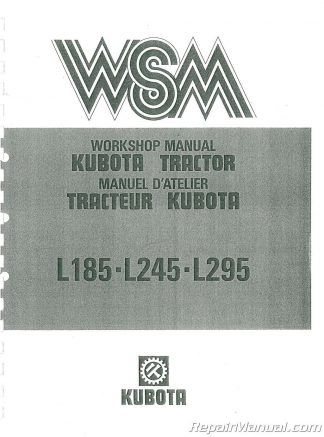Description
This Kubota L185 L245 L245DT and L295 Tractor Service Manual is a reproduction of the original out of print manual. It provides detailed service information, step-by-step repair instruction and maintenance specifications for KUBOTA L185, L245, L245DT and L295 tractors.
The contents of this Workshop Manual for Kubota L-Series Tractors are broken down into the following categories:
(1) Preliminary disassembly procedures required to disassemble each component parts.
(2) Disassembly and servicing procedures of tractor and engine components, along with procedures to locate and eliminate sources of mechanical breakdowns.
(3) The construction, names and functions of the major components of the hydraulic and electrical systems, along with their disassembly, check-up, servicing and troubleshooting.
The Chapter “Preliminary Disassembly” explains how to separate one block from the other before disassembling each component part: for example, how to separate the engine from the clutch housing and the clutch housing from the transmission case, etc. This chapter should be referred to in order to find out which block must be taken off to repair, check or service a given component part.
The Chapters “Engine”, “Tractor”, “Hydraulic System” and “Electrical System” give disassembly and servicing procedures in sequence along with respective reference values.
The Chapters “Hydraulic System” and “Electrical System” also include names of parts, explanation on component construction and functions to give a better understanding of disassembly, checking and servicing.
The troubleshooting charts are prepared to make it easy to trace the cause of a misfunction from abnormal conditions. For the convenience of quick trouble-tracing, servicing and checking jobs, reference pages are given with the sources of trouble so that you can find a full explanation in the text.
A list of symbols for fasteners, tools and test instruments is given on page 12. It will enable you to easily identify all the fasteners, tools and test instruments referred to in the text with the same symbols.
The article numbers for Kubota Tractor’s special tools, test instruments and disassembly bases (tables) are given at the end of each text.
Table of Contents
PREPARATORY STEPS FOR DISASSEMBLY AND SERVICING
1 SEPARATION OF FRONT AXLE
1-1 2-Wheel drive
1-2 4-Wheel drive
2 SEPARATION OF THE CLUTCH HOUSING FROM THE ENGINE
3 SEPARATION OF THE CLUTCH HOUSING FROM THE TRANSMISSION CASE
4 SEPARATION OF THE STEERING ASSEMBLY
5 DETACHING THE AXLE CASE
AND THE BRAKE
6 DETACHING THE DIFFERENTIAL
II ENGINE
DISASSEMBLY
1 CYLINDER HEAD
2 INJECTION PUMP
3 GEAR CASE
4 TIMING GEAR, CAM SHAFT, OIL PUMP
5 PISTON AND CRANKSHAFT
SERVICING
1 CYLINDER HEAD
(1) Compression pressure
(2) Distortion of cylinder head surface
(3) Dimensions of intake and exhaust valve seats
(4) Valve sinking
(5) Stem guide clearance
(6) Free length of valve spring
(7) Uprightness of valve spring
(8) Valve spring tension
(9) Oil clearance between rocker arm shaft
and bushing
(10) Top clearance
(11) Valve clearance
(12) Decompression clearance
(13) Air cleaner element
2 FUEL SYSTEM
(1) Cracking pressure in nozzle
(2) Fuel-tightness of nozzle valve seat
(3) Shape of fume across nozzle tip
(4) Fuel-tightness of fuel injection pump plunger
(5) Fuel-tightness of delivery valve of fuel injection pump
(6) Injection timing
(7) Replacing fuel filter
3 TIMING GEAR, CAMSHAFT
(1) Oil clearance of camshaft
(2) Camshaft flexure
(3) Heights of intake and exhaust cams
(4) Gear backlash
4 LUBRICATION
(1) Oil pressure
(2) Clearance btweeen inner and outer rotor
of oil pump
(3) Clearance between oil pump outer rotor
and body
(4) Oil filter
5 PISTON, CONNECTING ROD
(1) Piston pin hole
(2) Clearance between piston pin
and rod small-end bushing
(3) Piston ring gap
(4) Distortion and flexure of rod
6 CRANKSHAFT
(1) Crankshaft flexure
(2) Oil clearance between crank journal
and crankshaft metal 1
(3) Oil clearance between crank journal
and crankshaft metal 2
(4) Oil clearance between crank pin
and crank pin metal
(5) Crankshaft side clearance
7 CYLINDER LINER
(1) Wear of cylinder liner
8 COOLING SYSTEM
(1) Radiator leakage
(2) Radiator cap pressure
(3) Thermostat operating temperature
(4) Fan belt tension
TROUBLE SHOOTING
III TRACTOR BODY DISASSEMBLY
1 2-WHEEL DRIVE FRONT AXLE
2 4-WHEEL DRIVE FRONT AXLE
3 CLUTCH
4 STEERING SYSTEM
5 TRANSMISSION SYSTEM
(CLUTCH HOUSING SIDE)
6 TRANSMISSION SYSTEM (TRANSMISSION CASE SIDE)
7 2-PINION DIFFERENTIAL GEAR
8 4-PINION DIFFERENTIAL GEAR
9 REAR AXLE CASE
SERVICING
1 2-WHEEL DRIVE FRONT AXLE
(1) Clearance between center pin
and center pin bushing
(2) Suspension force of front axle
(3) Clearance between knuckle shaft
and king pin bushing
(4)- Knuckle shaft (upper, lower) plays
(5) Front wheel hub deflection
(6) Toe-in
(7) Camber, caster and king pin angles
2 4-WHEEL DRIVE FRONT AXLE
(1) Rotating torque of spiral bevel pinion shaft’ ,
(2) Differential gear rotating torque
(3) Backlash between spiral bevel pinion
and bevel gear
(4) Bevel gear backlash in bevel gear case
(5) Bevel gear backlash in axle case
(6) Clearance between knuckle pin
and its bushing
(7) Clearance between pinion bearing case
and front axle bracket bushing
(8) Clearance between center pin
and differential gear case bushing
(9) Clearance between drag link end
and knuckle pin
(10) Front axle suspension force
3 CLUTCH
(1) Clutch pedal play
(2) Safety switch action
(3) Wear of clutch disc and main shaft spline
(4) Clutch disc flatness
(5) Clutch disc wear
(6) Pressure plate and diaphragm flaws
(7) Thrust ball bearing
(8) Clutch lever wear and rust
4 STEERING SYSTEM
(1) Vertical jerking of steering wheel
(2) Steering wheel play
(3) Jerking of tie-rod end
5 TRANSMISSION SYSTEM
(1) Gear backlash
(2) Clearance between gear and spline
(3) Clearance between shift fork
and shift gear groove
(4) Free length of shift fork spring
(5) Clearance between reverse gear bushing
and reverse shaft
6 2-PINION DIFFERENTIAL GEAR
(1) Clearance between differential case
and differential side gear
(2) Clearance between differential pinion shaft and pinion gear
(3) Backlash between differential pinion
and differential side gear
(4) Differential gear rotating torque
(5) Backlash between spiral bevel pinion
and bevel gear
(6) Tooth contact between spiral bevel pinion and bevel gear
7 4-PINION DIFFERENTIAL GEAR
(1) Backlash between differential pinion
and differential side gear
8 REAR AXLE CASE
(1) Rear wheel drive gear backlash
9 BRAKE
(1) Brake pedal play
(2) Brake cam actuation
(3) Brake cam plate wear
(4) Brake cam plate flatness
(5) Brake disc wear
TROUBLE SHOOTING
IV HYDRAULIC POWER SYSTEM
SPECIFICATIONS
GEAR PUMP
1 CONSTRUCTION AND NAME OF PARTS
2 FUNCTION
3 DISASSEMBLY
4 SERVICING
(1) Gap between tooth crest of gear and body
(2) Wear of shaft
(3) Gap between bushing and shaft
(4) Length of bushings “A” and “C”
(5) Cleaning oil filter
5 BREAKING-IN AND CHECKS
• CHECKS BEFORE BREAKING-IN
5-1 Breaking-in procedures
5-2 Check
CONTROL VALVES AND LINKAGE
1 CONSTRUCTION AND NAME OF PARTS 1-1 Position control valve and linkage
(1) Control valve (L185, L245, L295)
(2) Linkage
1-2 Draft control valve and linkage
(1) Control valve (L295)
(2) Linkage
1-3 Relief valve
2 FUNCTION
2-1 Oil flow in position control valve
(1) When the spool is in the neutral position
(2) When the spool is in the up position
(3) When the spool is in the down position
(4) When the spool is in the floating position
2-2 Position control
(1) Lifting the implement
(2) Returning the spool to neutral
(3) Lowering the implement
(4) Returning the spool to neutral
2-3 Draft control
(1) When the draft control is in use (implement lifted)
(2) When the draft control is in use (implement lowered)
3 DISASSEMBLY
3-1 Position control valve
3-2 Draft control valve
4 SERVICING
4-1 Position control valve
(1) Spool faults
(2) Checking spool’s sliding motion
(3) Unloading valve faults
(4) Insufficient contact between check valve and seat
(5) Breakage and deformation of spring
(6) Insufficient contact between poppet valve
and seat plug
4-2 Draft control valve
(1) Spool faults
(2) Checking the sliding motion of spool
(3) Spring tension
5 ADJUSTMENT
5-1 Adjustment and checking
of relief valve set pressure
• Precautions for relief valve set
pressure adjustment
(1) Checking relief valve set pressure
(2) Adjusting the relief valve set pressure
5-2 Adjusting the linkage
(1) Position control•
(2) Draft control
HYDRAULIC CYLINDER
1 CONSTRUCTION AND NAME OF PARTS
2 FUNCTION
2-1 Oil flow in hydraulic cylinder
(1) When the lift arm goes up
(2) When the hydraulic lock operates
(3) When the hydraulic lock unlocks
3 DISASSEMBLY
4 SERVICING
(1) Wear and fault of hydraulic cylinder
(2) Scratch and deformation of piston, O-ring
and backup ring
(3) Clearance between hydraulic rod (set pin hole) and set pin
(4) Clearance between hydraulic arm shaft
and hydraulic arm shaft bushing
(5) Scratch on adjust collar
(6) Adjusting spool joint 1
(7) Operating force of control lever
TROUBLE SHOOTING
V ELECTRICAL SYSTEM
SPECIFICATIONS
BATTERY
1 CONSTRUCTION AND NAME OF PARTS
2 CHEMICAL ACTION
2-1 Chemical action in discharging
2-2 Chemical action in charging
3 DEFINITION OF BATTERY PERFORMANCE
3-1 Test end voltage
3-2 Capacity
4 CHECKING AND SERVICING
4-1 Routine checks
(1) Terminal and bolt looseness
(2) Cleaning the battery surface
(3) Checking electrolyte
4-2 Checking state of charge
(1) Checking with a hydrometer
(2) Checking with a battery tester
4-3 Recharging
(1) Slow charging
(2) Fast charging
4-4 Long-term Storage
(1) Checks before and after storage
ALTERNATOR AND REGULATOR
1 CONSTRUCTION AND NAME OF PARTS
1-1 Alternator
1-2 Regulator
2 CHARGING CIRCUIT
3 CHARGING OPERATION
3-1 Turning the main switch on
3-2 Low-speed running
3-3 Medium-speed running
3-4 High-speed running
4 CHECKS
(1) Rotorcoil, slip ring, brush
(2) Coupler voltage
(3) Output current
(4) No-load testing of alternator
(5) Diodes
(6) No-load regulating voltage
(7) Cut-in voltage
(8) Regulator check
5 DISASSEMBLY
6 SERVICING
(1) Slip ring
(2) Rotorcoil resistance
(3) Insulation between rotor coil and core
(4) Brush wear
(5) Stator coil breakage
(6) Stator coil short-circuit
(7) Checking positive diodes
(8) Checking negative diodes
STARTER AND GLOWPLUG
■ MAGNET SWITCH TYPE STARTER
1 CONSTRUCTION AND NAME OF PARTS
2 STARTING CIRCUIT
3 ELECTRICAL WIRING AND OPERATION
3-1 Switching the starter on
3-2 Contact plate is closed
3-3 Starter switch is released
4 CHECKS
(1) No-load testing
(2) Motor test
(3) Safety switch
5 DISASSEMBLY
6 SERVICING
(1) Pull-in coil (Attraction test)
(2) Holding coil (Retention test)
(3) Plunger return
(4) Pinion gap
(5) Gap between shaft and bush
(6) Armature flexure
(7) Armature coil short-circuit
(8) Armature coil breakage
(9) Armature coil grounding
(10) Uneven wear of commutator
(11) Staining or burning of commutator
(12) Mica (undercut)
(13) Field coil breakage
(14) Insulation between field coil and yoke
(15) Wear of brush
(16) Brush spring tension
(17) Brush holder
■ REDUCTION STARTER
1 CONSTRUCTION AND NAME OF PARTS
2 ELECTRICAL WIRING AND OPERATION
3 DISASSEMBLY
■ GLOWPLUG
1 CONSTRUCTION AND NAME OF PARTS
2 CHECKS
(1) Breakage and short-circuit of glow plug
TROUBLE SHOOTING
ELECTRICAL WIRING L185 • L245
ELECTRICAL WIRING L295


 SKU: KU-P-L35-PLUS
SKU: KU-P-L35-PLUS SKU: JS-KU-P-L225-AND-DT
SKU: JS-KU-P-L225-AND-DT SKU: K-201
SKU: K-201

